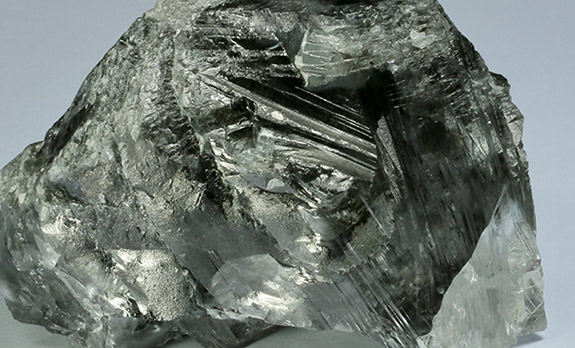September 22nd, 2021
The 1,175-carat rough diamond unearthed in June at Botswana's Karowe Mine made its Big Apple debut on Monday as the owners of the stone — mining company Lucara Diamond Corp and manufacturer HB Antwerp — revealed it to the press at the Whitby Hotel in upper midtown Manhattan.

Billed as the largest uncut diamond to ever visit the U.S., the massive stone will be the focus of a full week of viewings by New York diamantaires and other strategic partners.
“We’ve been in the business for many years, for quite some time, and these types of things do get us excited because of the sheer size,” HB Antwerp CEO Oded Mansori told Reuters.
The high-profile visit is also intended to raise the awareness and desirability of mined diamonds.

HB Antwerp has yet to determine whether the rough diamond will be left in its natural state or cut into a series of polished stones.
About the size of a baseball, the rough diamond measures 77mm (3.03in) long, 55mm (2.17in) wide and 33mm (1.3in) thick. The gem exhibits variable quality with significant domains of high-quality white gem material, according to Lucara.
Still unnamed, the 1,175-carat diamond ranks #3 on the list of the largest rough diamonds of all time, unseating the 1,109-carat Lesedi la Rona, which was discovered at the same Karowe Mine in 2015. Only two rough diamonds have ever tipped the scales at a higher weight, the 1,758-carat Sewelô (#2, Karowe Mine, 2019) and the 3,106-carat Cullinan Diamond (#1, Premier Mine, 1905).
When the Lucara's mammoth stone was unveiled in June, the mining company hinted that the 1,175-carat specimen was actually the largest fragment from a rough diamond that weighed more than 2,000 carats. Several other similar-color, sharp-edged chunks — weighing 471 carats, 218 carats and 159 carats — were all pulled during the same sorting process.
The gems were recovered by Lucara’s MDR (Mega Diamond Recovery) XRT circuit, a system that uses advanced technology to identify 100-carat-plus diamonds. By monitoring the rocky material for X-ray luminescence, atomic density and transparency, the technology can identify and isolate large diamonds before they go through the destructive crushing process. However, in this case, the system was not calibrated to identify a 2,000-plus-carat diamond. It got mashed by the primary crusher, one step ahead of the MDR.
"We do expect that we will recover more exceptional diamonds in excess of a thousand carats in size," Lucara's chief executive, Eira Thomas, told Reuters, "but on a global basis, this is still an extremely rare and unusual event.”
Back in April, HB Antwerp and Lucara signed a 12-month agreement in which the manufacturer committed to purchasing all of the rough diamonds larger than 10.8 carats extracted from the Karowe mine.
Credit: Images courtesy of Lucara Diamond Corp.

Billed as the largest uncut diamond to ever visit the U.S., the massive stone will be the focus of a full week of viewings by New York diamantaires and other strategic partners.
“We’ve been in the business for many years, for quite some time, and these types of things do get us excited because of the sheer size,” HB Antwerp CEO Oded Mansori told Reuters.
The high-profile visit is also intended to raise the awareness and desirability of mined diamonds.

HB Antwerp has yet to determine whether the rough diamond will be left in its natural state or cut into a series of polished stones.
About the size of a baseball, the rough diamond measures 77mm (3.03in) long, 55mm (2.17in) wide and 33mm (1.3in) thick. The gem exhibits variable quality with significant domains of high-quality white gem material, according to Lucara.
Still unnamed, the 1,175-carat diamond ranks #3 on the list of the largest rough diamonds of all time, unseating the 1,109-carat Lesedi la Rona, which was discovered at the same Karowe Mine in 2015. Only two rough diamonds have ever tipped the scales at a higher weight, the 1,758-carat Sewelô (#2, Karowe Mine, 2019) and the 3,106-carat Cullinan Diamond (#1, Premier Mine, 1905).
When the Lucara's mammoth stone was unveiled in June, the mining company hinted that the 1,175-carat specimen was actually the largest fragment from a rough diamond that weighed more than 2,000 carats. Several other similar-color, sharp-edged chunks — weighing 471 carats, 218 carats and 159 carats — were all pulled during the same sorting process.
The gems were recovered by Lucara’s MDR (Mega Diamond Recovery) XRT circuit, a system that uses advanced technology to identify 100-carat-plus diamonds. By monitoring the rocky material for X-ray luminescence, atomic density and transparency, the technology can identify and isolate large diamonds before they go through the destructive crushing process. However, in this case, the system was not calibrated to identify a 2,000-plus-carat diamond. It got mashed by the primary crusher, one step ahead of the MDR.
"We do expect that we will recover more exceptional diamonds in excess of a thousand carats in size," Lucara's chief executive, Eira Thomas, told Reuters, "but on a global basis, this is still an extremely rare and unusual event.”
Back in April, HB Antwerp and Lucara signed a 12-month agreement in which the manufacturer committed to purchasing all of the rough diamonds larger than 10.8 carats extracted from the Karowe mine.
Credit: Images courtesy of Lucara Diamond Corp.



